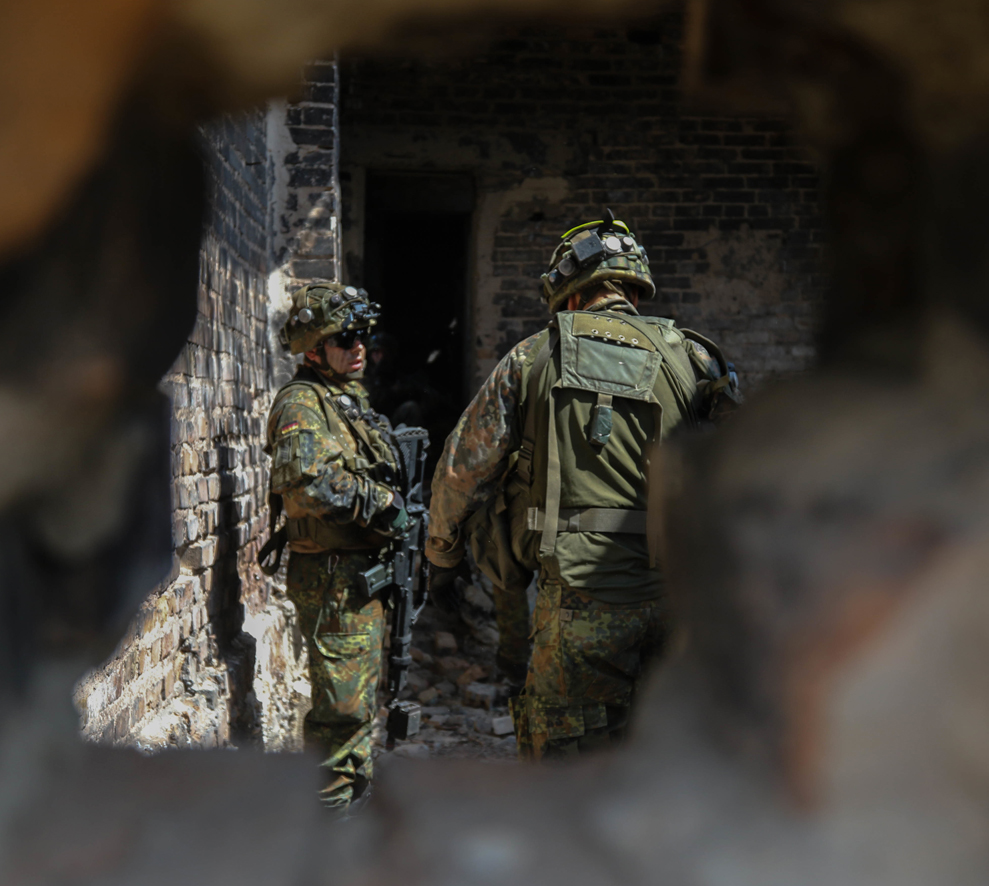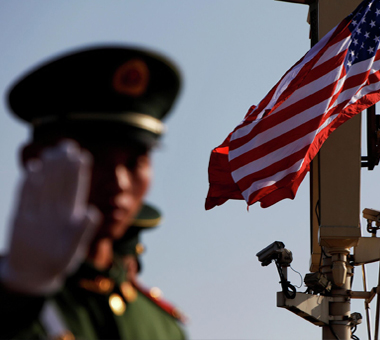Battlefields have witnessed a series of cumulative development qualitatively and quantitatively, driven by technological advancement and its influence in changing the mechanism and tools of ground engagements in the areas where military operations take place. Most strategists believe that technology is the key factor in determining the strength of an army and its capability to achieve a decisive victory, and thereby politically resolving the situation in spite of the differing types of engagement and the means of expressing conflict of interests.
These radical changes in the middle of the last century have provoked a conceptual revolution in the science of “Military Strategy”, a revolution that has far surpassed the accumulated knowledge since the formation of this science. Concepts such as “nuclear deterrence”, “arms race”, “air superiority”, “blitzkrieg”, and “proxy war” have only appeared after the end of World War II.
The present report discusses the strategic implications of the military technological advancement on the course of the war resolution, attempting to answer the following questions:
1. How does the military technological advancement impact conflicts in the Middle East?
2. Why would military technological advancement deem establishing a rational system of waging war unlikely?
3. What are the risks of over-reliance on “smart” military technology?
The Unique Nature of the New Middle Eastern Wars
“War” is a complex term for which it is difficult to reach consensus on one definition and determine its exact nature. Despite the change in the mechanisms and tools used to wage and control war, the essence and purpose of war remained well established. What the prominent strategist Carl Von Clausewitz (1780-1831) have stated about war and conflict still sounds logical in the age of hi-tech and the era of nanotechnology; he views war as only “a continuation of politics by other means, more violent and bloodier.” He also believes that the actual implementation of war is a conflict of wills that is intended to break and subordinate the enemy's will in order to achieve the country's ultimate strategic goal. According to Clausewitz, there are intertwining dimensions and reasons for waging war. One way is through the “Rational Approach” in which every political decision must take into account the expected gains and possible costs according to the equation:
Net Result = Gains and Benefits - Costs
Due to the wide-scale mutual destruction that results from any military confrontation between the two parties of the conflict, the expression of a contradiction of wills between states has drastically shifted away from a “direct war”. Instead, states began to shift their focus more on enhancing their defensive and offensive capabilities in order to deter their adversaries and to prepare for all scenarios imposed by the state’s requirements of survival and empowerment. Thus, Middle Eastern countries are either put under pressure –like Iran–, or exposed to frequent incidents targeting vital facilties on their territories –like Saudi Arabia–, but without sliding into a direct engagement between two Middle Eastern armies. This form of “hybrid warfare”, where different types of engagement are employed, requires the use of an advanced level of technology to serve the state's vital interests.
Experts believe that the region is approaching a new stage after unofficial armed groups have started to use GPS-based drones, marking a notable shift in the capabilities that can be held and controlled by informal powers independently of any official entity of any state. In addition to targeting Aramco facilities, drones were able to carry out multiple strikes on Russia's "Hmeimim" base in Syria despite its high-level security system. It is common for the observers of military developments to read news, almost on a weekly basis, pertaining to security breaches in which drones played the main role. This emphasizes the effect of military technology on the course of conflicts in the region, especially those who affect the regional balance of power. As the majority of these conflicts seem to be in the form of proxy wars, the development of such technologies must have been under the supervision and aid of the supporting countries or companies.
This technological breakthrough primarily stems from supplying semi-official groups with effective and crucial tools. Nonetheless, this breakthrough is not as advanced as the engagement mechanism. Rather, it transfers military equipment to out-of-state groups and breaks the state monopoly over the execution of major military missions. Specialists in Russia's Ministry of Defense warn from a future increase in the complexity and seriousness of attacks as Hmeimim attack suggests intricate planning and execution of operations that could not be carried out without the help and support of a particular entity. In September 2019, Major General Igor Konashenkov, the chief spokesperson for Russia's Ministry of Defense, revealed that terrorists are “constantly improving” their offense tactics using navigation and direction systems. Moreover, terrorists employ air command and control systems, and exchange of information among the offense planes used in their attacks. For Konashenkov, it is “worrying” that “whoever owned these technologies have supplied the terrorists with them”.
The horizontal transmission of power, which is the distribution of a particular type of arms to new parties, blurs the identity of the actual perpetrators and thus hinders the ability to track them and punish them. Besides, the country is obliged to adhere to International Law as opposed to armed groups who are not bound to treaties relating to waging war and the humanitarian and ethical aspects that must be followed militarily. This transfer of power necessitates redefining the connection between power and politics since armed groups were able to alter the balance of power even against a logistically superior opponent.
Many specialists note that Houthis succeeded in making an important strategic change, shifting from defensive to offensive tactics by targeting and attacking the depth of the Saudi territories. However, such a change could not have been possible without drones or similar advanced technologies.
Micro-Drone Swarm: The Next Generation of Drones
In January 2017, the Pentagon announced the first successful trial of a new system which was developed by its affiliate, the Strategic Capabilities Office. The test consisted of 103 Perdix drones that were launched from three F/A-18 Super Hornets. This successful demonstration is one of the very first instances in which the Pentagon employs teams of small, inexpensive, and autonomous systems to carry out missions that were once performed by large, man-guided, and costly units.
In the experiment, a 103 Micro-drone called “Perdix” –a Latin word that refers to a small-sized bird– had mimicked the movement of live flocks in nature. These Perdix units communicate through a "central brain" to make a collective decision after their specialized sensors collect field data. Since human involvement in this operation was minimal, this innovation is seen as a guarantee for the U.S. superiority over its opponents, and as a motivator to further develop its autonomous systems.
Although the statement did not include any crucial details regarding the project, specialized reports predict that micro-drones are part of a larger project by the Pentagon's Defense Advanced Research Projects “DARPA”. The project is named “Gremlins”, which refers to the imaginary, mischievous imps that were the good luck charms of many British pilots during World War II.
The advantage of drones in its different types generally lies in their ability to provide the necessary information regarding the military and security structures of adversaries. Because of their small size and ability to fly under the radar systems, micro-drones can break in the rearguard. In other scenarios, these drones can penetrate their opponent’s radio waves. Thus, military technology is approaching the day when drones are capable of airborne early warning and control (i.e. AEW&C) missions similarly to a manned AWACS aircraft. Furthermore, micro-drones would soon carry out missions of altering and controlling military waves.
“Black” Capabilities
In June 2019, a report by the Center for a New American Security raised concerns over the growing Chinese military resources; it became apparent that Chinese military capabilities have been competing with those of the U.S. military for the past two decades. The report also suggests that Chinese efforts seek to initially reach technological equivalence with the U.S. military and then achieve a technological superiority vis-à-vis the U.S. Moreover, China’s GDP would be the highest globally by 2030, manifesting an economic power that would support China's army in its endeavors.
The report refers to the possession of undetectable “black capabilities” by the Chinese army, leaving opponents susceptible to unexpected attacks as these capabilities would only be revealed upon the eruption of war. China continues to deploy its economic resources to support potential programs such as Assassin’s Mace, a program inspired from a folklore weapon called Shashoujian and seeks to destroy the opponent’s technological means in accordance with specific military assessments. In its broad sense, one of the definitions of the “State National Strategy” emphasizes that all the state’s political, economic, technological, or military resources shall serve the state's vital interest. Nonetheless, economy takes the lead in determining the situation of military policies in any state. Several military projects have been deemed unsuccessful or inactive due to the lack of funding.
The U.S. realizes the need to accommodate to the geostrategic changes of novel challenges and powers at the international level. In their report that is published in May 2019, Foreign Affairs magazine advocated for changing the manner in which the U.S. army currently performs its duties; the change entails the adoption of new kill chains through minimizing the huge and costly management systems in the battlefield rather than updating the current military arsenal. In this context, kill chains refer to the collection of interconnected channels of engagement that addresses field threats in order to use power promptly.
As survival is no longer to the strongest but rather to who is best capable of adapting to changes, the U.S. attempts to take the lead in novel military fields such as the aforementioned micro-drones. It also thrives to dominate fields that are yet to be discovered such as outer space.
During a ceremony held in August 2019 at the White House, President Donald Trump announced the launch of the U.S. Space Command as an independent entity of the Air Command, making it the sixth of the U.S. military branches. According to Trump’s statement, the establishment of this entity seeks to maintain the U.S. hegemony in space and to surpass the U.S. opponents, a reference to China and Russia, which threatened to "militarize the space" and having to reciprocate with similar measures.
Clearly indicating that the global military competition is heading towards a new space phase, the Chairman of the Joint Chiefs of Staff General Joseph Dunford emphasized that access to space through a collective military operation is crucial to preserve the U.S. competitive advantage in this war and its various fighting scales.
Observing the "New Stars War" and its impact on on-ground movements reveals the importance of controlling space to any country that seeks to attain major strategic gains. Neutralizing the military satellites of a given country entails losing its entire capability to control any operations, whether on land, sea, or air through this satellite. Moreover, hacking a country’s satellites would disclose or electronically disrupt the operations and commands managed by the satellite. At some point, it might be possible to control the opponent’s satellite to turn on the self-destruction system.
In addition to the dangers stemming from outer space, it is necessary to address the challenges emerging from cyberspace, in which rirsks are not only in the military aspects but also economic and personal i.e. related to the users' privacy. In a report published in February 2018, McAfee estimated that the annual cost of cybercrimes on the global economy is $400 billion, an amount that is nearly equal to the collective defense expenditure of the European Union countries.
Some military doctrines tend to percieve organized cyberattacks that are carried out by governments as a violation that entails a military action in accordance with the right of self-defense under Article 51 of the UN Charter which states that “nothing in the present Charter, shall impair the inherent right of individual or collective self-defense if an armed attack occurs against a Member of the United Nations...” Furthermore, legislators are readily trying to put in place legal provisions to address official or semi-official cyberattacks. In September 2019, the Ministry of the Armies in France took an unprecedented step, announcing the implementation of the International Law in cyberspace. For instance, France deems any aggressive cyber action a violation of its sovereignty which calls for a response in line with its national laws and customs. The rule applies whether the cyberattack was carried out by any government, either directly or indirectly, against the French digital infrastructure, or if the attack resulted in an economic or physical destruction, affected a vital sector, or resulted in loss of lives.
It is challenging to determine a “threshold” level for using cyberpower to an extent that constitutes an armed attack and where the assaulted country has a legitimate right of self-defense. Therefore, for a state to declare a “just” military action, it must abide by what is legally known as “Jus ad bellum”.
Based on past decisions issued by the International Court of Justice, armed attacks represent the most dangerous forms of power use and restrict any country from responding to these cyberattacks. On the other hand, a country might utilize cyberattacks to retaliate against a traditional military attack. For instance, in June 2019, Iran shot down a U.S. drone identified as RQ-4A Global Hawk, following which media outlets circulated news that USCYBERCOM has carried out a wide-range of cyberattacks against military communication networks used to launch missiles. Simultaneously, a cyberattack targeted an Iranian surveillance network that monitors navigation in the Strait of Hormuz. It is assumed that it has a role in the mid-June 2019 attacks on oil tankers in the Gulf of Oman.
Any response to a tangible violation might take place in a cyber world; a world that is not only tangible but even enrooted in the digital as well as physical infrastructure. By blurring the lines between what is digital and physical, and what is artificial and authentic, the founder of World Economic Forum Klaus Schwab anticipates that the fourth Industrial Revolution will have a far more significant impact than that created by steam engines, electricity, and computer systems. Nonetheless, the breakthrough brought by such a revolution in the field of military artificial intelligence is getting closer to enabling the technically-superior country from resolving a war before it even begins. This embodies the words of the pioneer in military strategy and author of The Art of War, Sun Tzu (496-551 BC), who advocated for “winning without a fight”. In hindsight, space wars, both outer and cyber, paint the features of the upcoming real clash whose features are beginning to unveil.
Two Sides of the Same Coin
Military technology can be viewed, from a more optimistic perspective, as a factor that restrained the behavior of military country. First, military technology has pushed for the production of traditional or nuclear weapons driven by the technological advancement to build an active deterrent system; such a defense system places grave and costly consequences of waging war on the perpetrating country. Second, the decision to wage a war is itself an irrational one since alternative –direct or indirect– technologies are available to avoid any military response from the targeted country and to refrain from offering legal justifications that allow for a military revenge. Conversely, military technology entails serious implications on international peace and security, including:
1. Reducing Predictability
The Offense-Defense Balance (ODB) theory attempts to pinpoint the main strategy of the armed forces of a country. An advanced country in defensive technological capabilities tends to build a more defense-based strategy, whereas an advanced country in offensive capabilities seeks a more offense-based strategy.
Based on the change in ODB theory, the military’s doctrine and strategy are susceptible to shift from offensive to defensive or vice versa; such a measure depends primarily on the relative evaluation of the country’s military capabilities compared to its adversaries, in addition to evaluating the defensive and offensive strategies within each country. When altering its balance of power, a country may prompt military action to overcompensate for its losses and setbacks. For instance, after the Nazi party in Germany expanded its military production qualitatively and quantitatively, Hitler proceeded to invade Poland in September 1939, marking the onset of World War II, according to historians.
Moreover, the German army would not have been successful in invading Poland without narrowing the power and capability gap with its opponents; such an approach was brought by the industrial progress in which iron and fossils were used to serve the war.
2. The Technological Superiority of Civilian Companies over Official Armies
In November 2014, the U.S. Defense Secretary Chuck Hegel announced the third compensation strategy which seeks cooperation between the private sector to preserve the technical superiority of the U.S. army over its counterparts –notably Russia and China. The strategy also aims at addressing the different global challenges such as terrorism; however, this requires the formation of a committee consisting of both civilians and military personnel to encourage technological innovation and to rely on global businesses in managing and developing these initiatives.
In October 2016, the Center for Strategic and International Studies (CSIS) hosted a conference titled "Assessment of the Third Compensation Strategy", where the U.S. Defense Secretary Ashton Carter revealed that the Defense Department needs to build a bridge with businesses to acquire and monitor any new emerging technologies. Carter also discussed the Pentagon’s pressing need to develop new operational concepts in line with the current reality and to utilize these businesses in dealing with the upcoming challenges that threaten the U.S. military domination.
The third compensation strategy could also be seen as a revolutionary change in the technological capabilities of official forces. Inventions such as the internet, radio wave, and microwave are the product of military development which then moved into the civil arena. Thus, the novel strategy recognizes that tech-businesses might have the upper hand over countries in some cases. Yet, there are existing risks that technology might fall into the wrong hands such as terrorist groups and organized gangs considering the confidentiality-related laws and regulations of these companies.
Due to the advanced technological level of social media applications, some judicial and security authorities find difficulty in accessing the conversations of suspects in national security cases or investigations. In a letter addressing Facebook sent in October 2019, leaders from the U.S., UK, and Australia demanded that the company halts its plans of the end-to-end encryption on its platforms until the company offers guarantees that authorities can access data of the cases under investigation or monitoring. In the letter, the three countries claimed that in 2018, there have been 16.8 million reports of possible incidents of child sexual abuse, noting that 70% of these reports would not be investigated if Facebook proceeds with its plans.
3. Stimulation of Technologically-Camouflaged Operations
Certain tools such as drones may tempt groups or governments to militarily target groups due to the low cost of such operations, the possibility of escaping legal consequences, and the nature of advanced technology that does not leave any trace of the perpetrator's identity.
4. The Decentralization of Power
With the development of production means and the diversity of suppliers, access to lethal technology has become smoother, enabling organized gangs and armed groups to acquire advanced weapons. The dispersion of power from its usual points entails the difficulty of tracking risk sources. As the notion of decentralized power deepens, the logistical and physical charges of facing the technology-related challenges would increase.
5. Over-Reliance on Unmanned Machines for Field Response
On the sidelines of the Joint International Conference on Artificial Intelligence held in July 2015, an open letter was issued, warning of the auto-arms that are capable of engaging with targets without human intervention. The letter also urged countries to immediately ban the military artificial intelligence (AI) to ensure that AI is not used to fuel an arms race where autonomous weapons become the future "Kalashnikov".
The number of signatories on the letter as of early October 2019 reached 30,000 scientists, 4500 of which are AI specialists. Nonetheless, these warnings did not find an echo within the international military community, in which confidentiality remains a barrier when establishing an internationally binding set of regulations for the military use of AI products.
The behavior and actions of AI products are hard to monitor once the products are out of control. It is when deciding to shoot would be automatic and subject to the decision of these "intelligent" weapons. What is more concerning is the ability of these robots to recognize and communicate with their counterparts. In fact, one robot was once able to recognize itself, which might pave the way for future recognition among other robots, a possibility that is often envisioned in science-fiction movies such as “I, Robot”.
There are rising concerns that artificial intelligence may increase the risk of “Miss Calculation” due to a technical malfunction or an intentional cyberattack, a risk that can be contained by human supervision.
A personal blog cited an incident that has not been verified yet, where a Soviet base in Siberia was able to track a nuclear ballistic missile targeting the Soviet territory. The missile remained on the surveillance screen for a few minutes, and based on the protocols of such a situation, the official in charge must launch an offensive nuclear missile without waiting for orders from the political and military leadership. Fortunately, the base official disobeyed the protocols and did not launch a missile. It was later discovered that the screen signs were only a result of technical malfunction. Therefore, the final decision must be made by a human, who thinks and feels, not a machine that automatically responds to its sensors.
Keep in touch
In-depth analyses delivered weekly.

Related Analyses:











